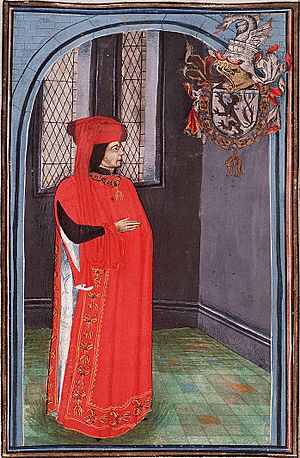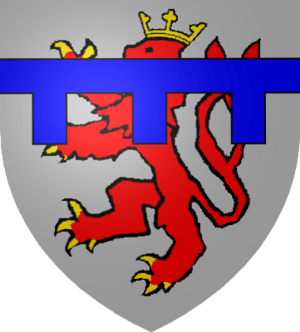John II, Count of Ligny facts for kids
Quick facts for kids
John II of Luxembourg
|
|
|---|---|
| Count of Ligny, Count of Guise, Lord of Beauvoir and Richebourg | |
 |
|
| Predecessor | Joan |
| Successor | Louis, Count of Saint-Pol |
| Born | 1392 |
| Died | 5 January 1441 Guise, France |
| Buried | Cambrai Cathedral |
| Family | House of Luxembourg |
| Spouse | Joan of Béthune (m. 1418) |
| Father | John of Luxembourg I |
| Mother | Margaret of Brienne |
John II of Luxembourg, Count of Ligny (born 1392 – died 5 January 1441) was an important French nobleman and soldier. He was a younger son of John of Luxembourg I and Margaret of Enghien. His older brother, Peter, inherited their mother's lands, including the County of Brienne. John II received the territory of Beaurevoir. In 1418, he married Joan of Béthune, who was the widow of Robert of Bar. John became a stepfather to Joan of Bar. He and Joan of Béthune did not have any children together.
Contents
John II's Life and Times
John II was part of the French branch of the House of Luxembourg. His family line went back six generations to Henry V, Count of Luxembourg.
Starting His Military Career
John II began his career working for John the Fearless, the Duke of Burgundy. This was during a time of civil war in France, known as the Armagnac-Burgundian Civil War. This war was a fight between two powerful French noble groups.
In 1414, John II of Luxembourg became the governor of Arras. He led several attacks on nearby areas controlled by the Armagnac group. In April 1418, he led a Burgundian army to help the city of Senlis, which was under attack by the Armagnacs. After the Burgundians took control of Paris in May of the same year, John II became the governor of Paris. He held this important position from 1418 to 1420.
Fighting in the Hundred Years' War
John II chose to support the English side during the Hundred Years' War. This was a long conflict between England and France. He led many military raids for the English leader, Regent Bedford. John II and his family were strong supporters of the English cause among the French nobles. His brother, Louis, who was a bishop, even became the chancellor of France for the Duke of Bedford.
Capturing Guise
In 1425, John II took control of the territory of Guise. He had been fighting over this land with René of Anjou. Guise was very important because it was the last Armagnac stronghold in northern France. It was also located strategically between Burgundy and the Burgundian Netherlands. John II had a claim to Guise because his ancestors, the Châtillon counts of Saint-Pol, used to own it. The Duke of Bedford recognized his claim.
John II, joined by an English force, attacked Guise. The city and its fortress, Hirson, officially surrendered to him on March 1, 1425.
Joan of Arc's Capture
In 1430, John II joined Philip III, Duke of Burgundy, in the Siege of Compiègne. During this siege, a soldier from John's company captured Joan of Arc. John sent Joan to Beaurevoir as a prisoner. Soon after, his aunt, Jeanne of Luxembourg, passed away and left him the County of Ligny.
Under pressure from both England and Burgundy, John II handed Joan over to the English for a large sum of money. She was later executed by the English.
Later Campaigns and Loyalty
The Count of Ligny continued to fight in France for several more years. He led some attacks in the area around Laon. From 1433, he campaigned in Picardy. He captured Haplincourt in 1433 and Saint-Valery in 1434.
In 1435, there was a peace meeting called the congress of Arras. John II was one of the people who strongly advised Philip of Burgundy not to make peace with the Armagnacs. However, Philip signed the Treaty of Arras with Charles VII of France. John II completely refused to sign this treaty. This made King Charles VII angry, and he allowed his soldiers to attack John's lands. From then on, John II had to deal with groups of soldiers, called écorcheurs, who raided his territories. In 1436, a commander named La Hire attacked Soissons, which belonged to John's daughter-in-law, Joan of Bar.
In early 1436, Duke Philip III asked John II to help make peace with the English. John's brother, Louis of Luxembourg, was involved in these talks. However, the English were very angry about Philip's actions, and war broke out between the former allies. In late 1437, the Duke of Burgundy asked John II for help to gather soldiers for the Burgundian attack on English-held Le Crotoy. John refused. He stated that he had always been loyal to his English allies and would not break that loyalty now.
His Final Years
John II of Luxembourg, Count of Ligny, died on January 5, 1441, in Guise. He never agreed to the Treaty of Arras. When he died, he left his lands to his nephew, Louis. However, King Charles VII took control of these lands. They were later given back to Louis.


